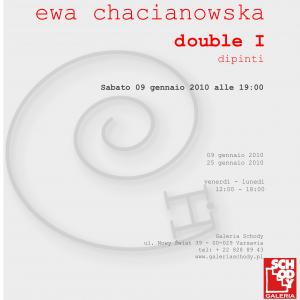If you divided the great global family of artists into two main groups, “mathematicians” and “poets,” you would find Ewa Chacianowska in the latter group. Her paintings and drawings are a sensitive seismograph of her complex personality. She works intuitively, and each day of work becomes a pretext for establishing a dialogue with her internal “I” – full of dilemmas, joyous, sad, torn by well-hidden emotions. Her series of paintings are a reflection of her experiences and internal quandaries. And not without a reason does she repeatedly use the same motif – of an anonymous human head, devoid of any personification that would allow to identify it with a specific individual.
A human head perceived this way may be seen as a symbol of the entire humanity and its perturbations. On a lesser scale, it can be interpreted as a sensitive image of the generation that the artist represents. In yet another step, you might say that the repeated motif of heads is an attempt of creating the artist’s own oneiric self-portrait. While interpreting in this way the works of an artist who at a young age decided to leave her home country and to settle in a place that is the cradle of modern era art, you can see certain analogies to the creative approach of Eva Hesse, one of the most permanent representatives of the American post-minimalism of the late 1960s. Like Eva Hesse, Ewa Chacianowska created expressive forms that reveal emotions of a person who has some dramatic political and personal experiences. And just like Eva Hesse, she feels the urge to keep returning to her home country in order to confront her recollections and concepts with the new reality.
Still, Chacianowska’s works are characterized by an omnipresent key element – lightly and freely treated color. In times of triumph, it is vivid, resonant and saturated. It seems to convey strong energy of a happy person who delights in fulfilling her dreams. This message can be noted in almost all of her paintings created in 2008, soon after her move to Milan, when everything in her life seemed to augur a substantial change. Sometimes her colors become pastel and delicate, telling of the most intimate emotions with subtle tones. This is particularly visible in the paintings from the last several years of her residence in Rome. There were also days, weeks and months dominated by the monochromatic palette of brown and ochre tones. This brings to mind associations with the place of Chacianowska’s birth and with the still vibrant cult of icon in Białystok region. The first paintings she created after moving from Poland to Italy are in fact a multiple contemporary interpretation of the same religious object. More than 10 years after painting her first Rome icons, the artist has returned to the subject, creating completely new paintings. They have preserved a similar color range but the remaining elements, like decisive lines, resonance of color and brush strokes, signal that Chacianowska is approaching the moment of achieving creative maturity. In other words, she is fully aware of what she wants to convey on canvas or paper, and that means both masterful technique and an ability to establish a dialogue with her inner “I”.
Chacianowska admits to her fascination with the paintings of Mark Rothko, one of the main representatives of the New York school of abstract expressionism. Her liking for the most color-sensitive painter of the artists promoted by the great Clement Greenberg is discernible in the way she puts colors on canvas. This fascination is visible in semi-transparent glaze layers of oil paint. Even if at some point the pigments are becoming dense, Chacianowska’s paintings always retain radiance, saturation and inner light, resembling the works of the American master. However, she has more in common with Rothko than just love for radiance, light and flatly distributed, pulsating color patches. From the Western history of art viewpoint, they are linked by the fact of being born in the same part of Europe. Białystok may be at some distance from Dvinsk, yet they both lie in the same cultural space, particularly when seen from a perspective of thousands of kilometers away.
The American artist created monumental monochromatic canvasses that he used for an inner, spiritual dialogue with the surrounding world. Chacianowska’s paintings are much smaller but she seems to follow in the footsteps of “her master” in search for spirituality. It seems quite astonishing in today’s world where young artists often attempt to adopt the strategies and tactics aimed at winning a position among the artistic elite. With Chacianowska, it is quite a different story: she seems to be completely indifferent to fads and is not capable of adjusting to art sellers’ expectations. She works like her other “master,” Balthus – in total isolation from popular trends, focused on her own artistic vision. Her only goal is to develop and master her own, original creative language.
Ewa Izabela Nowak
Paris, September 2009
Ewa Izabela Nowak holds a Ph.D. in arts from Paris 1 – Panthéon-Sorbonne university. Her Ph.D. dissertation discussed the influence of politics on arts in Poland under communist rule. She has written over 350 articles on art, published in Poland and in France, as well as a text on the Polish 20th-century art for the Dictionnaire mondial des images published by Nouveau Monde publishing house in France. She has collaborated with a number of magazines, including Archistorm, Azart and Beaux Arts Magazine in France, and Obieg, Arteon, Kwartalnik Rze%8;by Oro, Sztuka.pl, Kwartalnik Fotografii and Foto monthly in Poland.








Comments 0
Say something